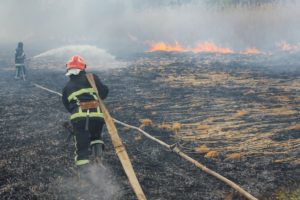One of the most destructive fires in California was the Mosquito Fire. It started at around 6:27 pm on Sept. 6, 2022, and was named for where it first ignited, near Mosquito Ridge Road.
What is the cause of the Mosquito Fire? The Mosquito Fire was completely contained by October 22. It consumed 76,788 acres of land, becoming the largest fire for the year in California. The fire destroyed 78 structures in Michigan Bluff and Foresthill in Placer County and Volcanoville in El Dorado County, causing over 11,000 people to evacuate.
When discussing the cause of the Mosquito Wildfire, it is important to understand how wildfires start and how electric companies’ actions or neglect can contribute. Wildfires are an issue all over the country, but these burning forests have been particularly devastating on the west coast of America.
Many factors contribute to wildfire outbreaks, such as drought, heat waves, and increased levels of atmospheric carbon dioxide, which dry out trees and vegetation making them more susceptible to ignition by lightning or humans. However, the electrical giant PG&E is to blame for millions of dollars of past fire damage and is likely the culprit for the Mosquito Fire. For more information, reach out to a Mosquito fire lawyer.
What Caused the Mosquito Wildfire of 2022?
While many people assume wildfires are caused by lightning strikes, unextinguished campfires, carelessly disposed charcoal or cigarette butts, or even arson, there’s another culprit here: electric companies.
In recent years, one electric company, in particular, has caused more than its fair share of wildfires in California. In 2014 PG&E was indicted, pleaded guilty to numerous felonies relating to starting the fires, and was sentenced to five years probation. At least 84 different accounts, including manslaughter and neglectful endangerment, were brought against PG&E during that time.
These new charges proved that the probation imposed on PG&E did little to prevent them from continuing the negligence that would cause fires and damages again in the future.
The Pacific Gas and Electric Company was sued for, once again, causing California’s largest wildfire this year (2022) after the utility told regulators a power line failure occurred around the time the fire started in the drought-ravaged Sierra Nevada foothills east of Sacramento.
The lawsuit, filed in state court in San Francisco, claims PG&E’s power lines ignited the Mosquito Fire when the utility’s equipment caused sparks to contact vegetation or the equipment itself contacted the vegetation.
What is a Wildfire?
A wildfire is any uncontrolled fire burning in a forest, grassland, or area of combustible vegetation that poses a potential risk to life and property. Wildfires can start from many causes, like lightning strikes or abandoned campfires. But climate change has made them more common than ever before. As the average global temperature increases, dry areas get drier and wet areas get wetter.
In the American West, warmer temperatures mean reduced snowpack and earlier spring melts, reducing water availability during summer months when wildfires are more likely to occur. Climate change has also been linked to the increased frequency and severity of wildfires worldwide.
What Causes so Many California Fires?
The first answer is that humans cause most fires, either through neglect or arson. The second and third most common causes are lightning strikes and naturally occurring forest fires. Wildfires can also result from power lines being too close to trees and bushes. When a tree branch falls on a power line and is caught, it creates an arc across the lines, which can start a fire.
Why California Specifically? Why not other states?
California is one of the most at-risk for wildfires. Over half of all wildfires in the US happen here. Plus, California often endures years-long drought that has worsened wildfire risks by drying out vegetation. Combustible vegetation is in every state, but nowhere are wildfires as common and destructive as they are in the dry forests of California.
Long droughts have made it much easier for wildfires to start and spread rapidly. For example, when a tree falls and hits a powerline, it can create an ember that would normally be put out by rain or moisture and, instead, turn into a much larger fire. When there is no rain in an area prone to wildfires, they are much more likely to happen and spread quickly.
How Do Electric Companies Play Into This?
 Electric companies are a major contributor to the number of wildfires in California. They have been using trees, which they consider waste wood, and burn them to generate electricity. Due to this practice, forests once filled with trees are now barren landscapes. The more tree branches and leaves that litter the ground, the easier it becomes for fires to spread.
Electric companies are a major contributor to the number of wildfires in California. They have been using trees, which they consider waste wood, and burn them to generate electricity. Due to this practice, forests once filled with trees are now barren landscapes. The more tree branches and leaves that litter the ground, the easier it becomes for fires to spread.
Electric companies also have a history of cutting down live vegetation around power lines and facilities, providing fuel for fast-moving fires when they start. The lack of trees also means less shade for plants and animals, which can lead to heat exhaustion or dehydration during droughts – contributing even further to fire risk.
However, the reason for the largest and most destructive fires is not weather conditions. While weather conditions cause the fire to spread, PG&E has a history of gross negligence and disregard for safety that could likely cause wildfires.
The California Mosquito Wildfire of 2022: Did PG&E Cause It Through Negligence?
Pacific Gas and Electric Company (PG&E) has long been one of the biggest energy providers in California. The company has a history of negligence, and recently two major wildfires were caused by the company’s faulty equipment in Northern California (the California Wildfires). Because they’ve already had several lawsuits filed against them and been found guilty of starting other fires, though the investigation into the Mosquito Fire has not been completed, empirical evidence suggests PG&E’s equipment caused the fire.
Pacific Gas and Electric
PG&E’s equipment started numerous fires, including the Dixie Fire, Camp Fire, Kincade Fire, and Zogg Fire. The circumstances of the Mosquito Fire appear very similar to those of previous fires. In each of those fires, the cause was PG&E’s failure to maintain their power lines or the vegetation surrounding them properly.
PG&E Past Negligence – San Bruno Gas line Explosion
Authorities indicted PG&E in 2014, four years after Line 132 exploded in a residential neighborhood of San Bruno on Sept. 9, 2010, killing eight people, injuring 58, and destroying 38 homes.
A jury found that PG&E willfully violated various safety standards for several of its pipelines, beginning with the company’s intentional failure to gather and integrate data. Prosecutors presented documents and emails proving that PG&E had inaccurate pipeline data on its GIS map.
In 2010 when Line 132 exploded, the pipe was listed as “seamless” in PG&E’s flawed record system. According to an expert witness, the pipe was welded with a long seam- which is considered more susceptible to ruptures.
The jury found that PG&E deliberately refused to identify and evaluate threats in Line 132 and did not include potential threats in its assessment plans. On top of that, the jury found PG&E guilty on two counts of purposely failing to identify pipeline problems as high-risk following scheduled spikes of pressure that surpassed the maximum allowed for those pipes.
Ordered Probation
Following the San Bruno Gas Line explosion, PG&E was placed on probation for five years. While on probation, PG&E set at least 31 wildfires, burned nearly one and one-half million acres, burned 23,956 structures, and killed 113 Californians. PG&E also pled guilty to 84 manslaughter charges for its ignition of the 2018 Camp Fire in Butte County and faced five felony and 28 misdemeanor counts from the 2019 Kincade Fire in Sonoma.
At the end of its probationary period, Judge William Alsup said “[that] PG&E [had] gone on a crime spree and will emerge from probation as a continuing menace to California.”
In 2018, the California Public Utilities Commission hit PG&E with a $1.6 billion fine, the largest penalty ever assessed against a utility company in the state’s history. Then in June of 2019, a federal jury found Pacific Gas and Electric guilty of five counts of violating pipeline safety laws and one count of obstructing an investigation of the 2010 San Bruno pipeline explosion. However, without explanation, prosecutors reduced PG&E’s fine from $562 million to $6 million.
Paradise Fire of 2018
The Camp Fire in Butte County, California, began the morning of Nov. 8, 2018, and burned a total of 153,336 acres, destroying 18,804 structures and resulting in 85 civilian fatalities and several firefighter injuries. The U.S. Forest Service believes the Camp Fire started by transmission lines operated by Pacific Gas and Electricity near the small town of Pulga. The wildfire spread due to dry vegetation, strong winds, and a lack of humidity. The investigation also determined there was a second ignition site caused by contact between vegetation and PG&E electrical lines.
Kincade Fire of 2019
PG&E’s faulty equipment also caused California wildfires in the fall of 2019 when their powerline ignited the Kincade fire, which burned an area of 77,000 acres in Northern California. Because of dry, windy conditions, the fire continued to burn for almost two weeks, causing it to reach across Sonoma County. Fire investigators say PG&E improperly configured equipment for a transmission tower, which caused increased stress on a worn jumper cable that failed and snapped off the tower, igniting the blaze.
Most of the region experienced planned power outages by PG&E due to the utility’s efforts to avoid the dangers of sparks. The utility left the more vital power transmission lines energized. It wasn’t until after the Kincade fire began that PG&E notified the commission that it had issues with transmission equipment near the fire.
A California Department of Forestry and Fire Protection investigation showed faulty PG&E equipment caused the fire that burnt 77,758 acres and destroyed 374 buildings. At the same time, the Public Utility Commission’s safety division also found that PG&E infrastructure had multiple violations.
What Does This Mean About the Mosquito Fire?
While the drought-like conditions, wind, and high temperatures may have contributed to the Mosquito Wildfire, Pacific Gas and Electricity’s negligence must be considered a factor.
As Judge William Alsup said about PG&E’s actions, “PG&E has blamed global warming, drought, and bark beetles. It’s true that those things made the wildfires worse. But there were reasons to step up compliance rather than slack off. And, those things didn’t start those fires. PG&E did that.”
Mosquito Fire Investigation Pending
An initial assessment from the U.S. Forest Service (USFS) concluded that the recent forest fire which broke out on National Forest System Lands was due to a line operated by PG&E. While the USFS has found that PG&E lines were the apparent cause of this fire, they are still performing a criminal investigation to determine liability.
Investigators continue to collect evidence from the fire – including removing and taking possession of PG&E’s transmission poles and attached equipment – to establish who is liable for the Mosquito Fire.
If you lost property or a loved one in the Mosquito Fire, a wildfire attorney can help you get the justice you need. Contact an experienced California wildfire lawyer for your free case consultation and start the process to pursue the compensation you deserve.
